Last updated: 15 September 2003
|
Last updated: 15 September 2003 |
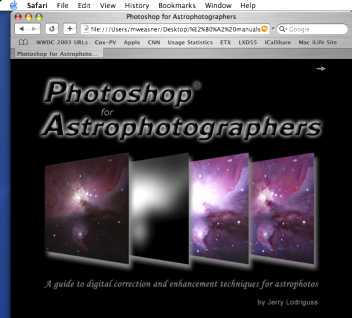 Photoshop for Astrophotographers
Photoshop for Astrophotographers
by Jerry Lodriguss
$39.95
Available on CD-ROM (Mac and PC) from http://www.astropix.com as a web browser based book.
As described in the Introduction, "The main purpose of this book is to describe and illustrate techniques for properly adjusting, correcting and enhancing astronomical images in Adobe Photoshop image-processing software." I will try to tell you how well it does that. One caveat: I have been using Photoshop for several years and recently upgraded to version 7 for Mac OS X. While I don't use all of its features I at least know a little about using Photoshop. Hopefully my basic knowledge of Photoshop is fairly common amoung amateur astronomers who may want to get more out of their digital and scanned film astrophotography. I should also point out that many graphics editors can do some of what Photoshop can do. So even if you don't have Photoshop (or one of its inexpensive cousins), you may still learn some techniques from this book that will be applicable in your graphics editor, whether it is on Mac, Mac OS X, Windows, or Unix.
To read this book will require a web browser. I used Apple Computer's Safari. One drawback to this is when you need to stop reading and resume later; you have to use the web browser's bookmark command or history feature. If you are using bookmarks, as you continue reading through the book you have to delete the previous bookmarks. Not a major problem but just something to be aware when reading this book. Most of the web pages and graphics for the book on on the CD-ROM but where appropriate there are links to websites where you can find additional information. One distinct advantage of this web-based is that image rollovers can be used to change what is seen in the browser. When showing before and after photos, this works extremely well.
The book's table of contents includes:
1. Perceiving and Recording Light
2. Astrophotography
3. Scanning
4. Photoshop
5. Archiving and Output
A Gallery of Astrophoto Images
Appendix
Searchable Index
The book begins with a good and thorough explanation of light and vision, and describes the differences between vision and photography. There is a lot of technical data here but understanding light and how it is perceived and captured can pay benefits when doing image processing. It then moves on to some astrophotography basics and offers a lot of good advice on what equipment to buy for those wanting to start doing astrophotography. Most of the advice is geared to serious 35mm film and CCD astrophotography but can still be useful to lower-end astrophotography. The first three chapters don't deal with the title topic (Photoshop) but is still a valuable resource for new and moderately experienced astrophotographers. Various types of astrophotography, objects, and cameras are discussed. There is a good explanation of several focusing techniques. It then moves on to image display and processing.
The Photoshop section starts with setting up various settings in Photoshop for optimum use and includes some basic information on using Photoshop. It starts out with good explanations and techniques using a terrestial scene photograph before moving on to working with astronomical images. At first I found this strange (since the book is about editing astrophotographs) but then I realized that it actually makes good sense to start with familiar images to show how Photoshop can improve images. This establishes a good basis to move on to working with astrophotographs. There are some basic steps that can improve the deep sky images; these are presented in a logical fashion with excellent examples along the way. Then the book moves on to explain several advanced techniques for deep sky astrophotography.
The book uses real-world examples with real astrophotography, with lots of images and explanatory text. There is good use of before and after images as it describes the techniques used. The book is technical where it needs to be but you can follow the examples without being overwhelmed with the technical stuff. Near the end, the author has added a lot of miscellaneous topics, many of which could be important to you, such as storage and display of your astrophotographs. And finally, the book ends with gallery of beautiful astrophotographs. These demonstrate what can be done and should inspire you to try your hand at editing your own astrophotographs just to see what you might be able to do (select below for one of my astrophotos where I followed some of the techniques from the book). There is also a nice appendix and an excellent searchable index.
A single read through the book will let you know what you CAN do to improve your astrophotography images but to get the most out of your images will require lots of time studying the techniques and manipulating your own photographs. The book provides you with techniques that range from simple to complex. How you use that knowledge is up to you. This is a good book if you want to get serious about the computer side of astrophotography.
So, how well can you improve an astrophoto using the techniques in the book? Of course, that depends a lot on the original photo you are editing but here is one of my photographs of M45, the Pleiades, taken in March 2002 using a piggybacked Nikon Coolpix 995 using a JMI Piggy-back Camera Mount. This photo was 35 seconds at maximum optical zoom.
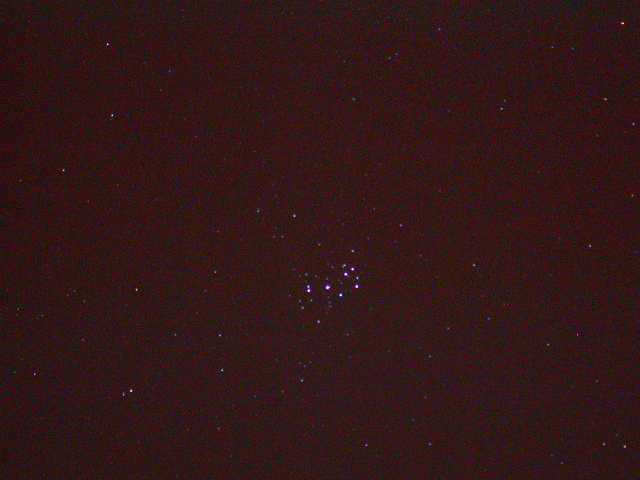
This photo was stacked with another one that was 60 seconds using Keith's Image Stacker v3.3 for Mac OS X to yield this image:

I then followed the book page "Step by Step Astronomical Example" (file:///Photoshop%20for%20Astrophotography/BOOK/F_PS/F03/F03.HTM) and edited the stacked image in Photoshop 7 for Mac OS X. In the example you first set the black and white points, adjust the midtone brightness, correct the color, do a curves adjustment, increase the contrast, do some tweaking, and finally apply an unsharp mask filter. I won't show all the immediate steps but here is the final result:
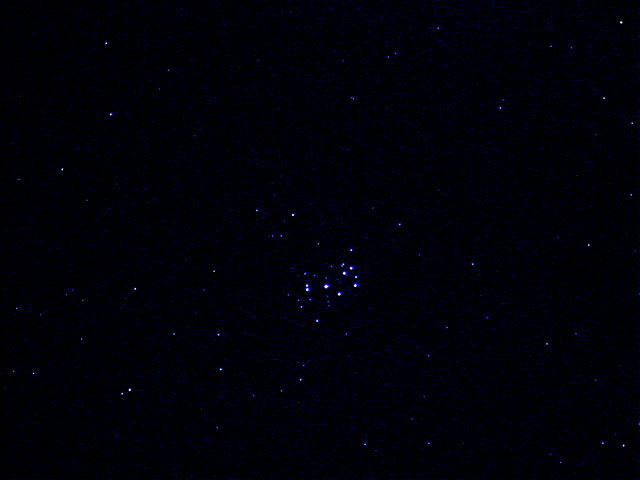
This Pleiades example is a simple one that I tried just to learn the steps. There really isn't much improvement other than darkening the sky background.
The following image showing Orion's belt and sword (and M42, the Great Nebula in Orion) is a better one.
First up is a photo taken in March 2002 using a piggybacked Nikon Coolpix 995. This photo was 60 seconds with full optical zoom.
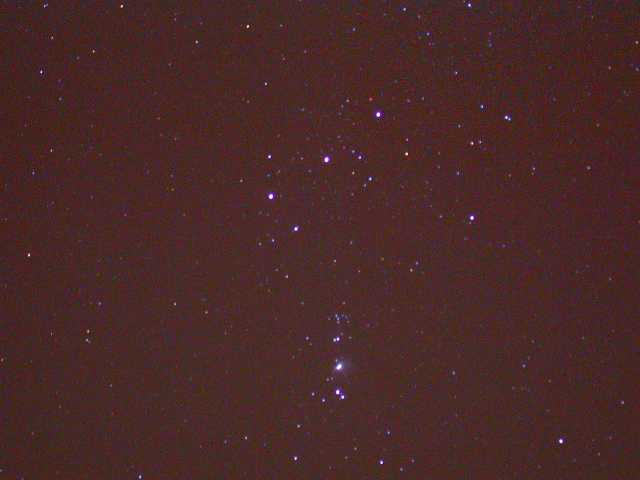
Next is a stacked image using Keith's Image Stacker v3.3 for Mac OS X. Three images, 16, 33, and 60 seconds, were stacked to yield this:
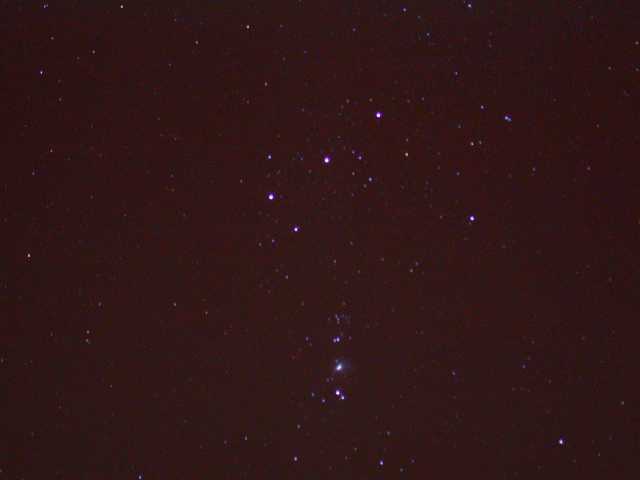
And, doing some of the editing described in the book, I quickly managed this image:
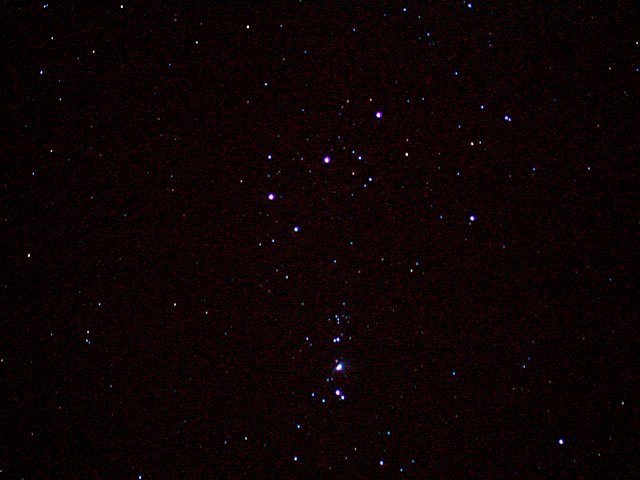
OK, but what could I have done with just a single 60 second shot? Here is a quick edit (adjusting levels):
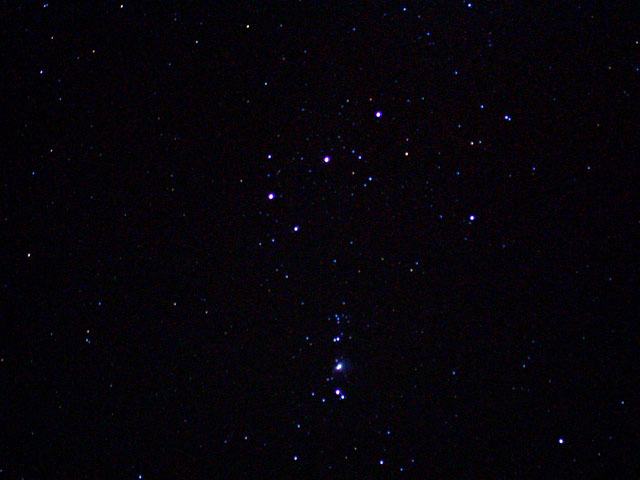
I personally think the stacked and edited photo is slightly better with star colors showing better against the sky background. But there is not much in the way of nebulosity surrounding Orion (like you see in much longer exposures from much darker skies).
But as you can see, these limited originals don't have much in the way of details that would be brought out by using the techniques described in the book. But here is a more detailed view of M42 in Orion. This next shot is an 8 second exposure using afocal photography. A Scopetronix 25mm eyepiece on my ETX-90RA was used. The Scopetronix Digi-T System was used to mount the Coolpix.
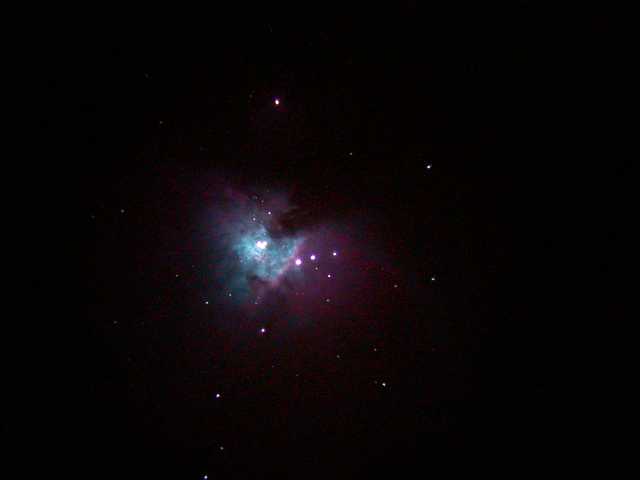
Here is a stack of 2, 4, and 8 second exposures using Keith's Image Stacker:

And after doing some of the edits from the book, I ended up with this:
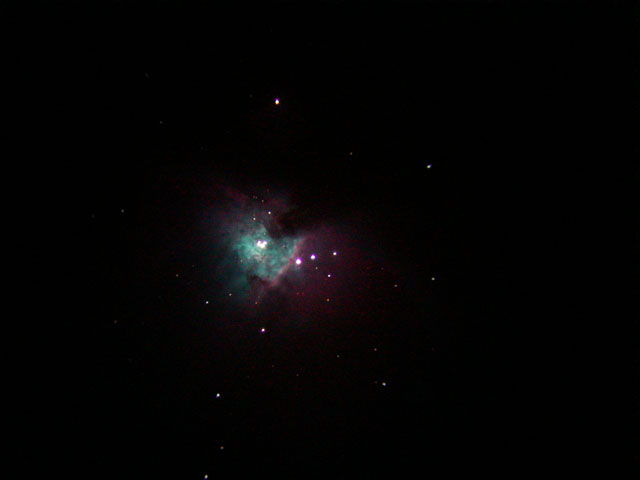
The above view shows something similar to what might be seen through an eyepiece, although typically only the greenish area is seen through small telescopes. But the Trapezium comes through nice and clear. But what about a single frame shot, like this 14 second one:
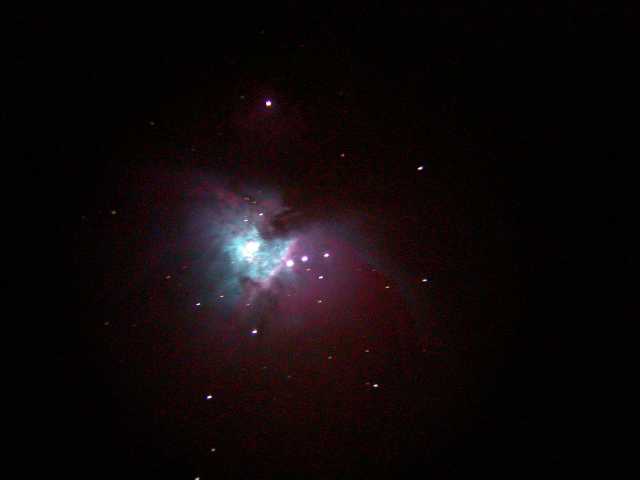
Here is what I was able to quickly do with it:
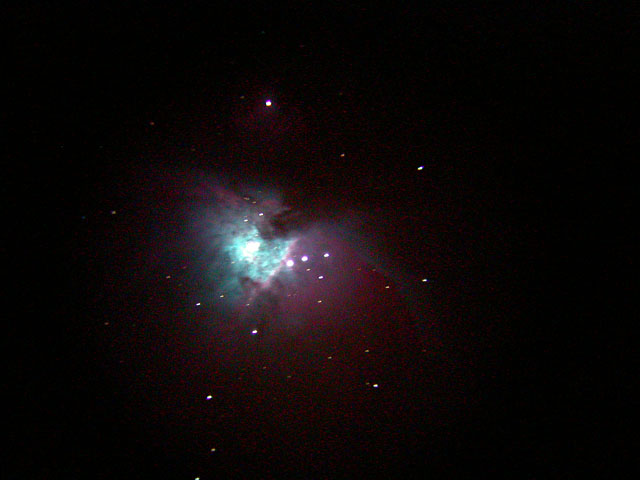
There is more nebulosity visible in the single edited frame (and even in the unedited 14 second exposure) than in the edited stacked image but the edited stack image shows more details near the Trapezium, showing the value of stacking, even with a very small number of stacked images.
Even with some quick edits using the tips and techniques in this book, you can improve many, but probably not all, of your film and digital astrophotographs. And having really dark skies and many images to stack can certainly provide a better starting point to apply the techniques from this book.
Return to the top of this page.
Go back to the Astrophotography Page.
Go back to my ETX Home Page.